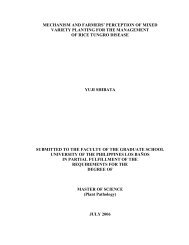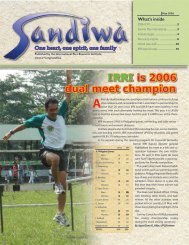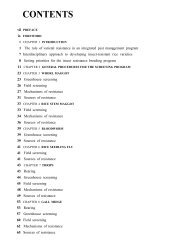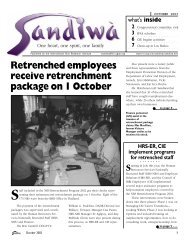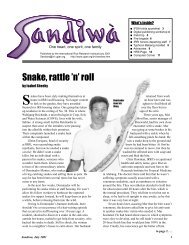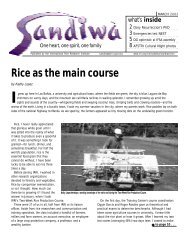Untitled - International Rice Research Institute
Untitled - International Rice Research Institute
Untitled - International Rice Research Institute
Create successful ePaper yourself
Turn your PDF publications into a flip-book with our unique Google optimized e-Paper software.
% infected seed lots<br />
100<br />
80<br />
60<br />
40<br />
20<br />
Alternaria padwickii<br />
Sarocladium oryzae<br />
Fusarium moniliforme<br />
Bipolaris oryzae<br />
Pyricularia grisea<br />
Tilletia barclayana<br />
0<br />
1989 1990 1991 1992 1993 1994 1995 1996 1997<br />
Year<br />
Fig. 1. Detection of common seedborne fungal pathogens of rice from exported seeds at IRRI, 1989-97.<br />
Table 2. Level of fungal pathogens detected from seeds, field observations on seed planted in the field after<br />
treatment, disease incidence, and level of fungal infection detected from harvested seeds (24 entries; 1996 dry<br />
season).<br />
Field inspection for disease<br />
Fungal pathogen RSHT a at receipt (%) Disease %<br />
Entries infected RSHT at harvest<br />
Alternaria padwickii 15.7 Stackburn 0 A. padwickii 10.7<br />
Curvularia spp. 5.4 Black kernel 0 Curvularia spp. 9.0<br />
Sarocladium oryzae 0.8 Sheath rot 2 (8.3%) S. oryzae 2.7<br />
Gerlachia oryzae 2.7 Leaf scald 2 (8.3%) G. oryzae 0.2<br />
Fusarium moniliforme 0.2 Bakanae 0 F. moniliforme 3.8<br />
Bipolaris oryzae 1.7 Brown spot 0 B. oryzae 0.4<br />
Pyricularia grisea 0 Blast 1 (4.1%) P. grisea 0<br />
Phoma sp. 1.6 Glume blight 0 Phoma sp. 4.6<br />
Tilletia barclayana 0.3 Kernel smut 0 T. barclayana 0<br />
Disease-free 19 entries (79%)<br />
a<br />
RSHT = routine seed health test. Seed treatment applied: hot water, 52–57°C for 15 min plus Benlate and Dithane M-45 at 0.1% by seed weight.<br />
lum of seedborne pathogens and diseases in the field.<br />
Postintroduction measures<br />
“Damage control” often refers to actions taken to<br />
minimize damage after it has happened. The concept<br />
can be applied to seedborne fungal pathogen management<br />
by relating it to postquarantine treatment.<br />
There is always concern that if a pathogen is unintentionally<br />
introduced into a country or region, it may<br />
cause potential damage to the crop. The entry of infected<br />
seeds when seed lots are brought into a country<br />
is unavoidable. However, it is still not clear<br />
whether the infected seed being introduced will begin<br />
an infection of the crop in the field. It is desirable to<br />
limit the probability of infection. Several<br />
postquarantine treatments can be applied to control<br />
such damage. Many of these postquarantine treatments<br />
provide measures to counteract the introduction<br />
of undesirable pathogens (Table 2).<br />
Seed health testing is important to assure the<br />
safe movement of seed on the one hand and to control<br />
the spread of seedborne diseases through seed<br />
movement on the other hand.<br />
Seed treatment and seed health testing to eliminate<br />
potential pathogens are damage control steps<br />
intended to avoid the introduction of key pathogens.<br />
Currently available information or control measures<br />
in place may not be adequate. Some control measures,<br />
such as seed treatment, successfully check the<br />
movement of pathogens from the seed.<br />
5



